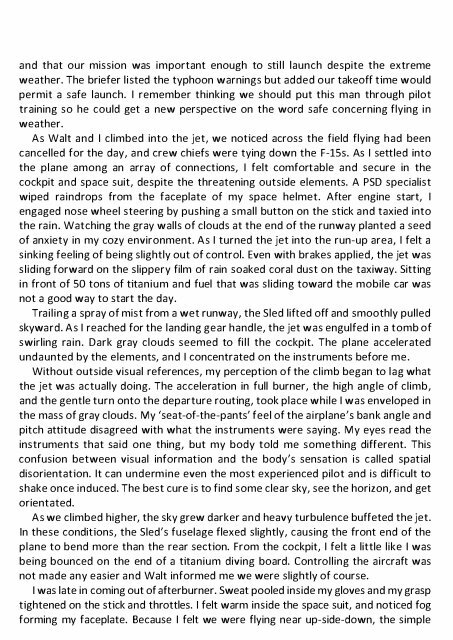You also want an ePaper? Increase the reach of your titles
YUMPU automatically turns print PDFs into web optimized ePapers that Google loves.
and that our mission was important enough to still launch despite the extreme<br />
weather. The briefer listed the typhoon warnings but added our takeoff time would<br />
permit a safe launch. I remember thinking we should put this man through pilot<br />
training so he could get a new perspective on the word safe concerning flying in<br />
weather.<br />
As Walt and I climbed into the jet, we noticed across the field flying had been<br />
cancelled for the day, and crew chiefs were tying down the F-15s. As I settled into<br />
the plane among an array of connections, I felt comfortable and secure in the<br />
cockpit and space suit, despite the threatening outside elements. A PSD specialist<br />
wiped raindrops from the faceplate of my space helmet. After engine start, I<br />
engaged nose wheel steering by pushing a small button on the stick and taxied into<br />
the rain. Watching the gray walls of clouds at the end of the runway planted a seed<br />
of anxiety in my cozy environment. As I turned the jet into the run-up area, I felt a<br />
sinking feeling of being slightly out of control. Even with brakes applied, the jet was<br />
sliding forward on the slippery film of rain soaked coral dust on the taxiway. Sitting<br />
in front of 50 tons of titanium and fuel that was sliding toward the mobile car was<br />
not a good way to start the day.<br />
Trailing a spray of mist from a wet runway, the <strong>Sled</strong> lifted off and smoothly pulled<br />
skyward. As I reached for the landing gear handle, the jet was engulfed in a tomb of<br />
swirling rain. Dark gray clouds seemed to fill the cockpit. The plane accelerated<br />
undaunted by the elements, and I concentrated on the instruments before me.<br />
Without outside visual references, my perception of the climb began to lag what<br />
the jet was actually doing. The acceleration in full burner, the high angle of climb,<br />
and the gentle turn onto the departure routing, took place while I was enveloped in<br />
the mass of gray clouds. My 1Seat-of-the-pants' feel of the airplane's bank angle and<br />
pitch attitude disagreed with what the instruments were saying. My eyes read the<br />
instruments that said one thing, but my body told me something different. This<br />
confusion between visual information and the body's sensation is called spatial<br />
disorientation. It can undermine even the most experienced pilot and is difficult to<br />
shake once induced. The best cure is to find some clear sky, see the horizon, and get<br />
orientated.<br />
As we climbed higher, the sky grew darker and heavy turbulence buffeted the jet.<br />
In these conditions, the <strong>Sled</strong>'s fuselage flexed slightly, causing the front end of the<br />
plane to bend more than the rear section. From the cockpit, I felt a little like I was<br />
being bounced on the end of a titanium diving board. Controlling the aircraft was<br />
not made any easier and Walt informed me we were slightly of course.<br />
I was late in coming out of afterburner. Sweat pooled inside my gloves and my grasp<br />
tightened on the stick and throttles. I felt warm inside the space suit, and noticed fog<br />
forming my faceplate. Because I felt we were flying near up-side-down, the simple


